Case Study Of Clinical Integration Specialty Practice
VerifiedAdded on 2022/10/04
|10
|2811
|20
Assignment
AI Summary
Contribute Materials
Your contribution can guide someone’s learning journey. Share your
documents today.
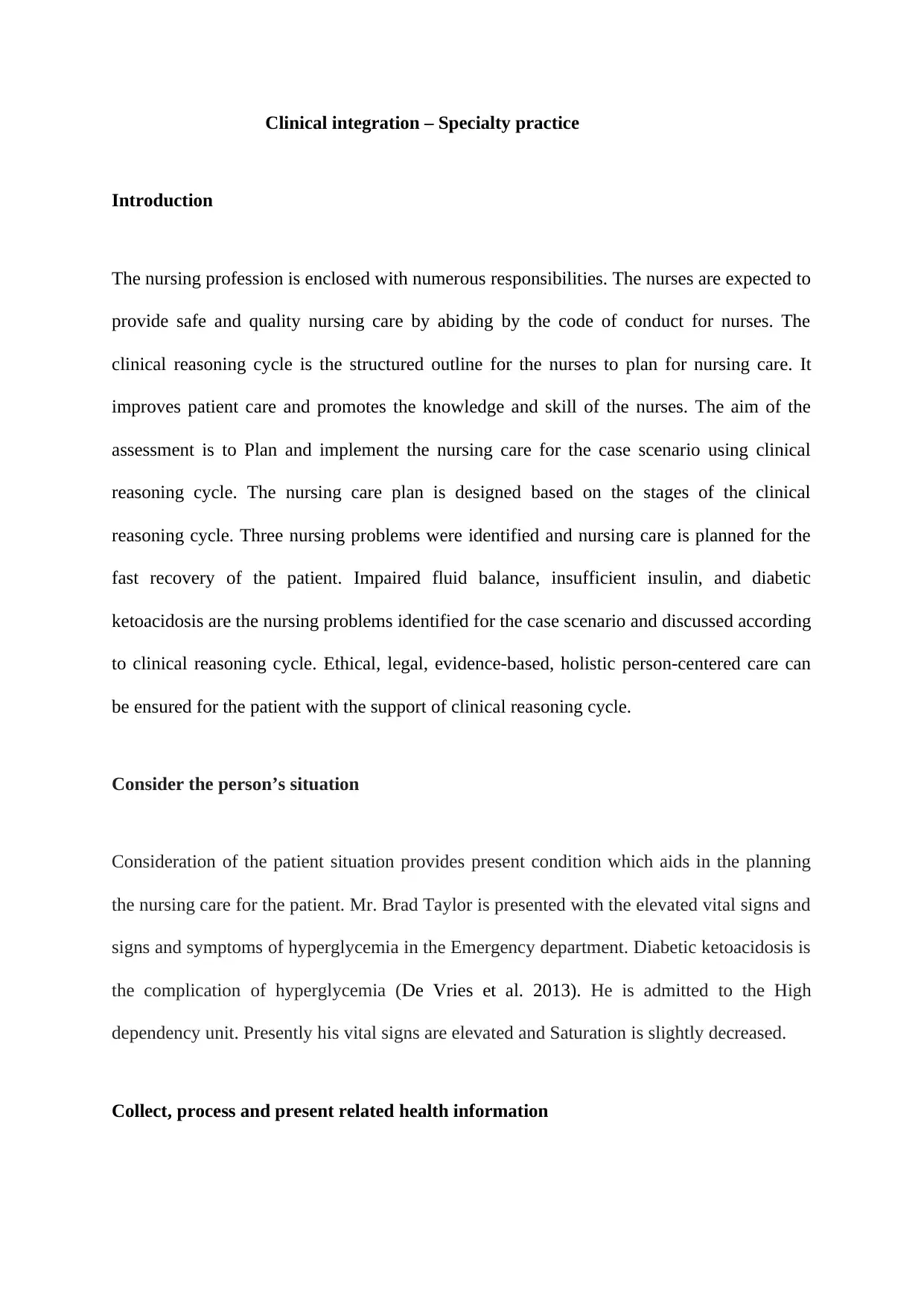
Clinical integration – Specialty practice
Introduction
The nursing profession is enclosed with numerous responsibilities. The nurses are expected to
provide safe and quality nursing care by abiding by the code of conduct for nurses. The
clinical reasoning cycle is the structured outline for the nurses to plan for nursing care. It
improves patient care and promotes the knowledge and skill of the nurses. The aim of the
assessment is to Plan and implement the nursing care for the case scenario using clinical
reasoning cycle. The nursing care plan is designed based on the stages of the clinical
reasoning cycle. Three nursing problems were identified and nursing care is planned for the
fast recovery of the patient. Impaired fluid balance, insufficient insulin, and diabetic
ketoacidosis are the nursing problems identified for the case scenario and discussed according
to clinical reasoning cycle. Ethical, legal, evidence-based, holistic person-centered care can
be ensured for the patient with the support of clinical reasoning cycle.
Consider the person’s situation
Consideration of the patient situation provides present condition which aids in the planning
the nursing care for the patient. Mr. Brad Taylor is presented with the elevated vital signs and
signs and symptoms of hyperglycemia in the Emergency department. Diabetic ketoacidosis is
the complication of hyperglycemia (De Vries et al. 2013). He is admitted to the High
dependency unit. Presently his vital signs are elevated and Saturation is slightly decreased.
Collect, process and present related health information
Introduction
The nursing profession is enclosed with numerous responsibilities. The nurses are expected to
provide safe and quality nursing care by abiding by the code of conduct for nurses. The
clinical reasoning cycle is the structured outline for the nurses to plan for nursing care. It
improves patient care and promotes the knowledge and skill of the nurses. The aim of the
assessment is to Plan and implement the nursing care for the case scenario using clinical
reasoning cycle. The nursing care plan is designed based on the stages of the clinical
reasoning cycle. Three nursing problems were identified and nursing care is planned for the
fast recovery of the patient. Impaired fluid balance, insufficient insulin, and diabetic
ketoacidosis are the nursing problems identified for the case scenario and discussed according
to clinical reasoning cycle. Ethical, legal, evidence-based, holistic person-centered care can
be ensured for the patient with the support of clinical reasoning cycle.
Consider the person’s situation
Consideration of the patient situation provides present condition which aids in the planning
the nursing care for the patient. Mr. Brad Taylor is presented with the elevated vital signs and
signs and symptoms of hyperglycemia in the Emergency department. Diabetic ketoacidosis is
the complication of hyperglycemia (De Vries et al. 2013). He is admitted to the High
dependency unit. Presently his vital signs are elevated and Saturation is slightly decreased.
Collect, process and present related health information
Secure Best Marks with AI Grader
Need help grading? Try our AI Grader for instant feedback on your assignments.
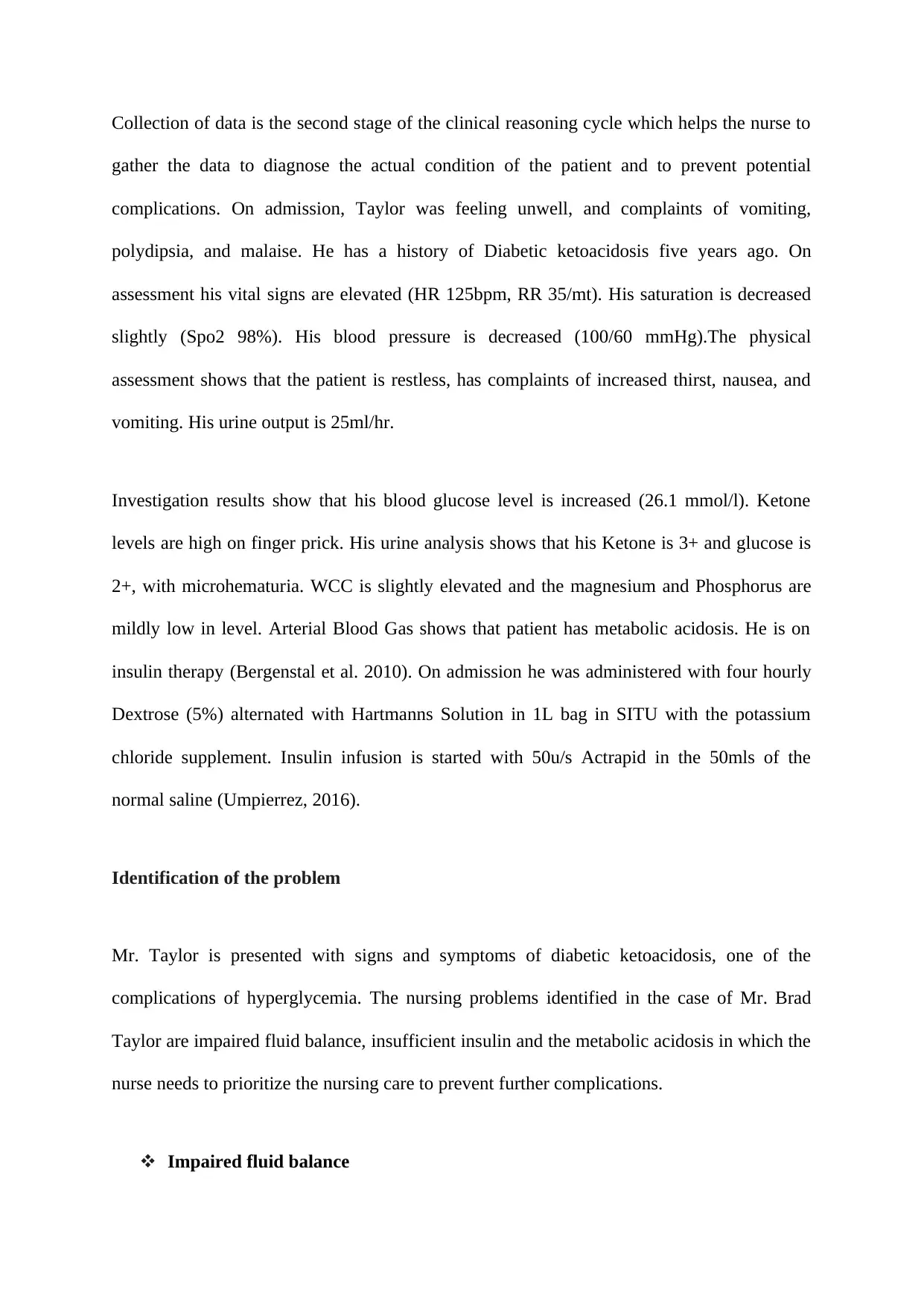
Collection of data is the second stage of the clinical reasoning cycle which helps the nurse to
gather the data to diagnose the actual condition of the patient and to prevent potential
complications. On admission, Taylor was feeling unwell, and complaints of vomiting,
polydipsia, and malaise. He has a history of Diabetic ketoacidosis five years ago. On
assessment his vital signs are elevated (HR 125bpm, RR 35/mt). His saturation is decreased
slightly (Spo2 98%). His blood pressure is decreased (100/60 mmHg).The physical
assessment shows that the patient is restless, has complaints of increased thirst, nausea, and
vomiting. His urine output is 25ml/hr.
Investigation results show that his blood glucose level is increased (26.1 mmol/l). Ketone
levels are high on finger prick. His urine analysis shows that his Ketone is 3+ and glucose is
2+, with microhematuria. WCC is slightly elevated and the magnesium and Phosphorus are
mildly low in level. Arterial Blood Gas shows that patient has metabolic acidosis. He is on
insulin therapy (Bergenstal et al. 2010). On admission he was administered with four hourly
Dextrose (5%) alternated with Hartmanns Solution in 1L bag in SITU with the potassium
chloride supplement. Insulin infusion is started with 50u/s Actrapid in the 50mls of the
normal saline (Umpierrez, 2016).
Identification of the problem
Mr. Taylor is presented with signs and symptoms of diabetic ketoacidosis, one of the
complications of hyperglycemia. The nursing problems identified in the case of Mr. Brad
Taylor are impaired fluid balance, insufficient insulin and the metabolic acidosis in which the
nurse needs to prioritize the nursing care to prevent further complications.
Impaired fluid balance
gather the data to diagnose the actual condition of the patient and to prevent potential
complications. On admission, Taylor was feeling unwell, and complaints of vomiting,
polydipsia, and malaise. He has a history of Diabetic ketoacidosis five years ago. On
assessment his vital signs are elevated (HR 125bpm, RR 35/mt). His saturation is decreased
slightly (Spo2 98%). His blood pressure is decreased (100/60 mmHg).The physical
assessment shows that the patient is restless, has complaints of increased thirst, nausea, and
vomiting. His urine output is 25ml/hr.
Investigation results show that his blood glucose level is increased (26.1 mmol/l). Ketone
levels are high on finger prick. His urine analysis shows that his Ketone is 3+ and glucose is
2+, with microhematuria. WCC is slightly elevated and the magnesium and Phosphorus are
mildly low in level. Arterial Blood Gas shows that patient has metabolic acidosis. He is on
insulin therapy (Bergenstal et al. 2010). On admission he was administered with four hourly
Dextrose (5%) alternated with Hartmanns Solution in 1L bag in SITU with the potassium
chloride supplement. Insulin infusion is started with 50u/s Actrapid in the 50mls of the
normal saline (Umpierrez, 2016).
Identification of the problem
Mr. Taylor is presented with signs and symptoms of diabetic ketoacidosis, one of the
complications of hyperglycemia. The nursing problems identified in the case of Mr. Brad
Taylor are impaired fluid balance, insufficient insulin and the metabolic acidosis in which the
nurse needs to prioritize the nursing care to prevent further complications.
Impaired fluid balance
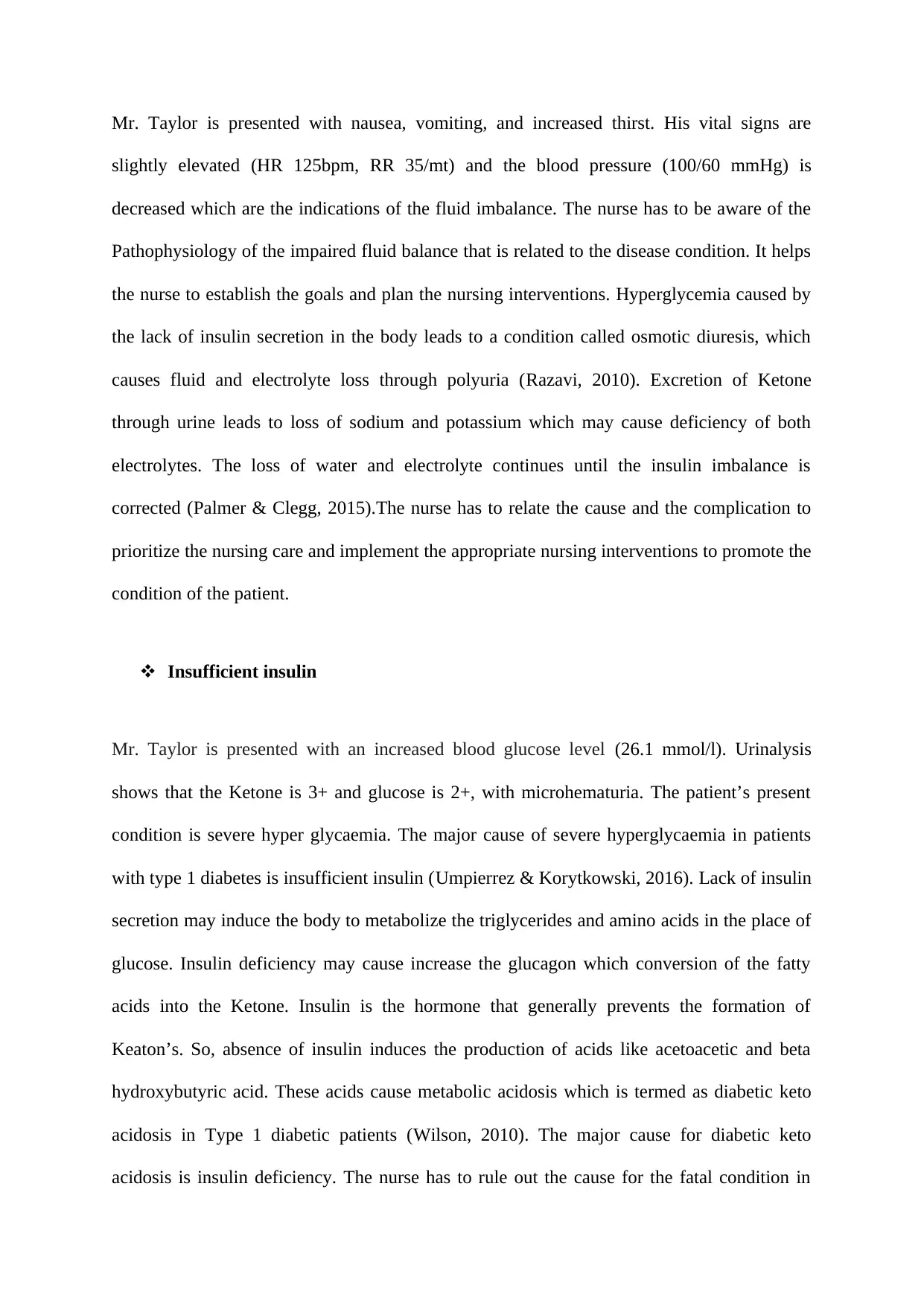
Mr. Taylor is presented with nausea, vomiting, and increased thirst. His vital signs are
slightly elevated (HR 125bpm, RR 35/mt) and the blood pressure (100/60 mmHg) is
decreased which are the indications of the fluid imbalance. The nurse has to be aware of the
Pathophysiology of the impaired fluid balance that is related to the disease condition. It helps
the nurse to establish the goals and plan the nursing interventions. Hyperglycemia caused by
the lack of insulin secretion in the body leads to a condition called osmotic diuresis, which
causes fluid and electrolyte loss through polyuria (Razavi, 2010). Excretion of Ketone
through urine leads to loss of sodium and potassium which may cause deficiency of both
electrolytes. The loss of water and electrolyte continues until the insulin imbalance is
corrected (Palmer & Clegg, 2015).The nurse has to relate the cause and the complication to
prioritize the nursing care and implement the appropriate nursing interventions to promote the
condition of the patient.
Insufficient insulin
Mr. Taylor is presented with an increased blood glucose level (26.1 mmol/l). Urinalysis
shows that the Ketone is 3+ and glucose is 2+, with microhematuria. The patient’s present
condition is severe hyper glycaemia. The major cause of severe hyperglycaemia in patients
with type 1 diabetes is insufficient insulin (Umpierrez & Korytkowski, 2016). Lack of insulin
secretion may induce the body to metabolize the triglycerides and amino acids in the place of
glucose. Insulin deficiency may cause increase the glucagon which conversion of the fatty
acids into the Ketone. Insulin is the hormone that generally prevents the formation of
Keaton’s. So, absence of insulin induces the production of acids like acetoacetic and beta
hydroxybutyric acid. These acids cause metabolic acidosis which is termed as diabetic keto
acidosis in Type 1 diabetic patients (Wilson, 2010). The major cause for diabetic keto
acidosis is insulin deficiency. The nurse has to rule out the cause for the fatal condition in
slightly elevated (HR 125bpm, RR 35/mt) and the blood pressure (100/60 mmHg) is
decreased which are the indications of the fluid imbalance. The nurse has to be aware of the
Pathophysiology of the impaired fluid balance that is related to the disease condition. It helps
the nurse to establish the goals and plan the nursing interventions. Hyperglycemia caused by
the lack of insulin secretion in the body leads to a condition called osmotic diuresis, which
causes fluid and electrolyte loss through polyuria (Razavi, 2010). Excretion of Ketone
through urine leads to loss of sodium and potassium which may cause deficiency of both
electrolytes. The loss of water and electrolyte continues until the insulin imbalance is
corrected (Palmer & Clegg, 2015).The nurse has to relate the cause and the complication to
prioritize the nursing care and implement the appropriate nursing interventions to promote the
condition of the patient.
Insufficient insulin
Mr. Taylor is presented with an increased blood glucose level (26.1 mmol/l). Urinalysis
shows that the Ketone is 3+ and glucose is 2+, with microhematuria. The patient’s present
condition is severe hyper glycaemia. The major cause of severe hyperglycaemia in patients
with type 1 diabetes is insufficient insulin (Umpierrez & Korytkowski, 2016). Lack of insulin
secretion may induce the body to metabolize the triglycerides and amino acids in the place of
glucose. Insulin deficiency may cause increase the glucagon which conversion of the fatty
acids into the Ketone. Insulin is the hormone that generally prevents the formation of
Keaton’s. So, absence of insulin induces the production of acids like acetoacetic and beta
hydroxybutyric acid. These acids cause metabolic acidosis which is termed as diabetic keto
acidosis in Type 1 diabetic patients (Wilson, 2010). The major cause for diabetic keto
acidosis is insulin deficiency. The nurse has to rule out the cause for the fatal condition in
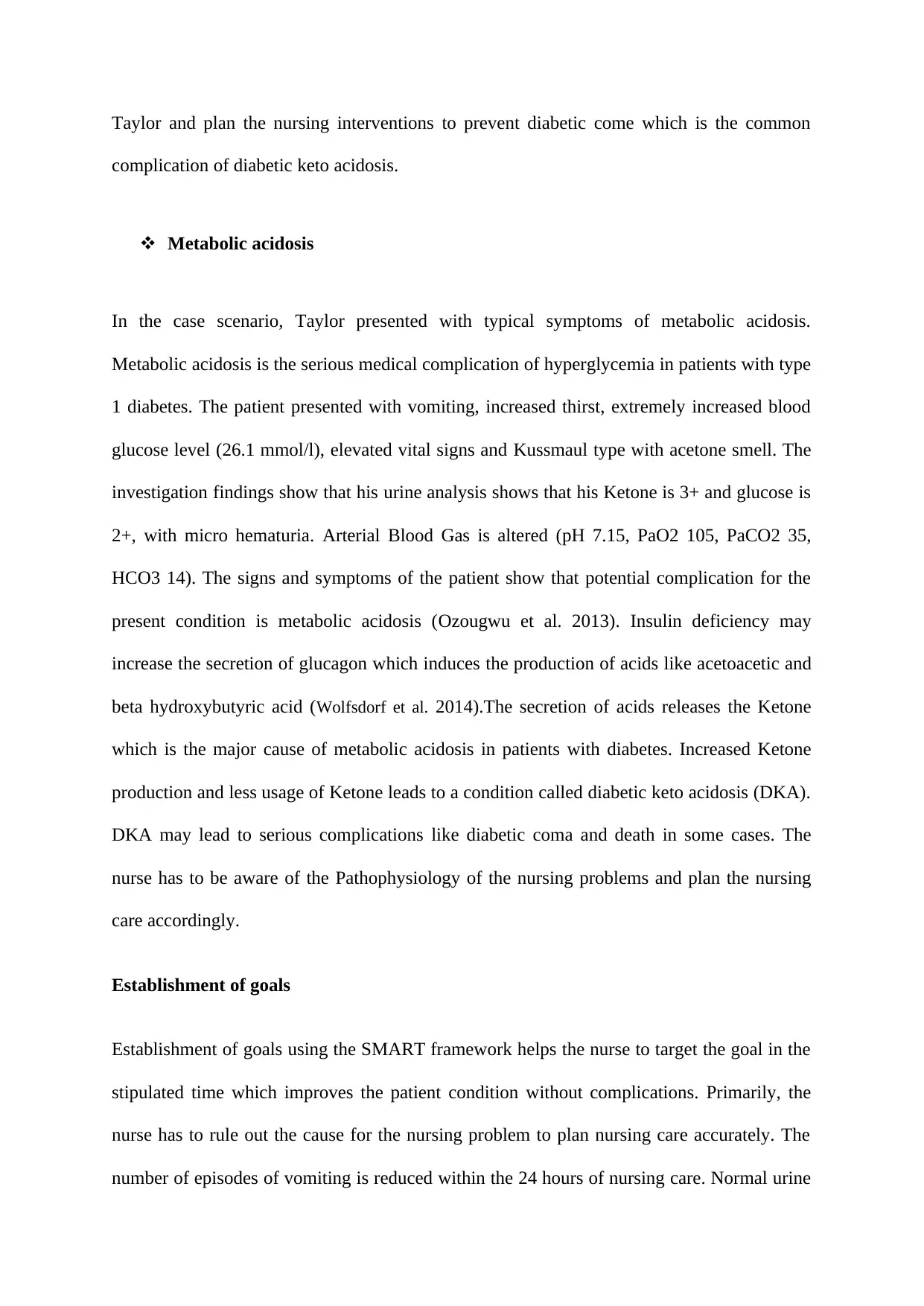
Taylor and plan the nursing interventions to prevent diabetic come which is the common
complication of diabetic keto acidosis.
Metabolic acidosis
In the case scenario, Taylor presented with typical symptoms of metabolic acidosis.
Metabolic acidosis is the serious medical complication of hyperglycemia in patients with type
1 diabetes. The patient presented with vomiting, increased thirst, extremely increased blood
glucose level (26.1 mmol/l), elevated vital signs and Kussmaul type with acetone smell. The
investigation findings show that his urine analysis shows that his Ketone is 3+ and glucose is
2+, with micro hematuria. Arterial Blood Gas is altered (pH 7.15, PaO2 105, PaCO2 35,
HCO3 14). The signs and symptoms of the patient show that potential complication for the
present condition is metabolic acidosis (Ozougwu et al. 2013). Insulin deficiency may
increase the secretion of glucagon which induces the production of acids like acetoacetic and
beta hydroxybutyric acid (Wolfsdorf et al. 2014).The secretion of acids releases the Ketone
which is the major cause of metabolic acidosis in patients with diabetes. Increased Ketone
production and less usage of Ketone leads to a condition called diabetic keto acidosis (DKA).
DKA may lead to serious complications like diabetic coma and death in some cases. The
nurse has to be aware of the Pathophysiology of the nursing problems and plan the nursing
care accordingly.
Establishment of goals
Establishment of goals using the SMART framework helps the nurse to target the goal in the
stipulated time which improves the patient condition without complications. Primarily, the
nurse has to rule out the cause for the nursing problem to plan nursing care accurately. The
number of episodes of vomiting is reduced within the 24 hours of nursing care. Normal urine
complication of diabetic keto acidosis.
Metabolic acidosis
In the case scenario, Taylor presented with typical symptoms of metabolic acidosis.
Metabolic acidosis is the serious medical complication of hyperglycemia in patients with type
1 diabetes. The patient presented with vomiting, increased thirst, extremely increased blood
glucose level (26.1 mmol/l), elevated vital signs and Kussmaul type with acetone smell. The
investigation findings show that his urine analysis shows that his Ketone is 3+ and glucose is
2+, with micro hematuria. Arterial Blood Gas is altered (pH 7.15, PaO2 105, PaCO2 35,
HCO3 14). The signs and symptoms of the patient show that potential complication for the
present condition is metabolic acidosis (Ozougwu et al. 2013). Insulin deficiency may
increase the secretion of glucagon which induces the production of acids like acetoacetic and
beta hydroxybutyric acid (Wolfsdorf et al. 2014).The secretion of acids releases the Ketone
which is the major cause of metabolic acidosis in patients with diabetes. Increased Ketone
production and less usage of Ketone leads to a condition called diabetic keto acidosis (DKA).
DKA may lead to serious complications like diabetic coma and death in some cases. The
nurse has to be aware of the Pathophysiology of the nursing problems and plan the nursing
care accordingly.
Establishment of goals
Establishment of goals using the SMART framework helps the nurse to target the goal in the
stipulated time which improves the patient condition without complications. Primarily, the
nurse has to rule out the cause for the nursing problem to plan nursing care accurately. The
number of episodes of vomiting is reduced within the 24 hours of nursing care. Normal urine
Secure Best Marks with AI Grader
Need help grading? Try our AI Grader for instant feedback on your assignments.
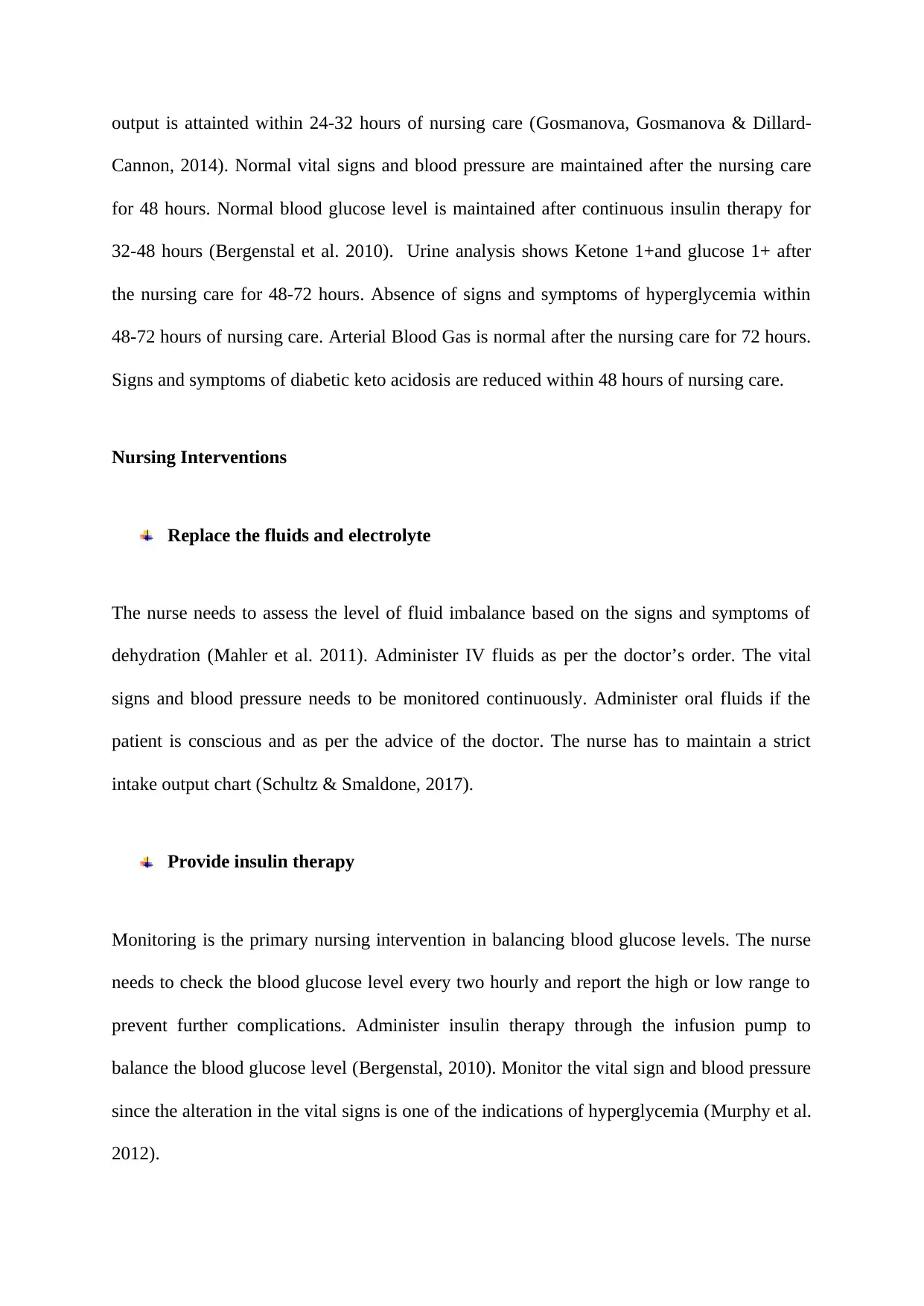
output is attainted within 24-32 hours of nursing care (Gosmanova, Gosmanova & Dillard-
Cannon, 2014). Normal vital signs and blood pressure are maintained after the nursing care
for 48 hours. Normal blood glucose level is maintained after continuous insulin therapy for
32-48 hours (Bergenstal et al. 2010). Urine analysis shows Ketone 1+and glucose 1+ after
the nursing care for 48-72 hours. Absence of signs and symptoms of hyperglycemia within
48-72 hours of nursing care. Arterial Blood Gas is normal after the nursing care for 72 hours.
Signs and symptoms of diabetic keto acidosis are reduced within 48 hours of nursing care.
Nursing Interventions
Replace the fluids and electrolyte
The nurse needs to assess the level of fluid imbalance based on the signs and symptoms of
dehydration (Mahler et al. 2011). Administer IV fluids as per the doctor’s order. The vital
signs and blood pressure needs to be monitored continuously. Administer oral fluids if the
patient is conscious and as per the advice of the doctor. The nurse has to maintain a strict
intake output chart (Schultz & Smaldone, 2017).
Provide insulin therapy
Monitoring is the primary nursing intervention in balancing blood glucose levels. The nurse
needs to check the blood glucose level every two hourly and report the high or low range to
prevent further complications. Administer insulin therapy through the infusion pump to
balance the blood glucose level (Bergenstal, 2010). Monitor the vital sign and blood pressure
since the alteration in the vital signs is one of the indications of hyperglycemia (Murphy et al.
2012).
Cannon, 2014). Normal vital signs and blood pressure are maintained after the nursing care
for 48 hours. Normal blood glucose level is maintained after continuous insulin therapy for
32-48 hours (Bergenstal et al. 2010). Urine analysis shows Ketone 1+and glucose 1+ after
the nursing care for 48-72 hours. Absence of signs and symptoms of hyperglycemia within
48-72 hours of nursing care. Arterial Blood Gas is normal after the nursing care for 72 hours.
Signs and symptoms of diabetic keto acidosis are reduced within 48 hours of nursing care.
Nursing Interventions
Replace the fluids and electrolyte
The nurse needs to assess the level of fluid imbalance based on the signs and symptoms of
dehydration (Mahler et al. 2011). Administer IV fluids as per the doctor’s order. The vital
signs and blood pressure needs to be monitored continuously. Administer oral fluids if the
patient is conscious and as per the advice of the doctor. The nurse has to maintain a strict
intake output chart (Schultz & Smaldone, 2017).
Provide insulin therapy
Monitoring is the primary nursing intervention in balancing blood glucose levels. The nurse
needs to check the blood glucose level every two hourly and report the high or low range to
prevent further complications. Administer insulin therapy through the infusion pump to
balance the blood glucose level (Bergenstal, 2010). Monitor the vital sign and blood pressure
since the alteration in the vital signs is one of the indications of hyperglycemia (Murphy et al.
2012).
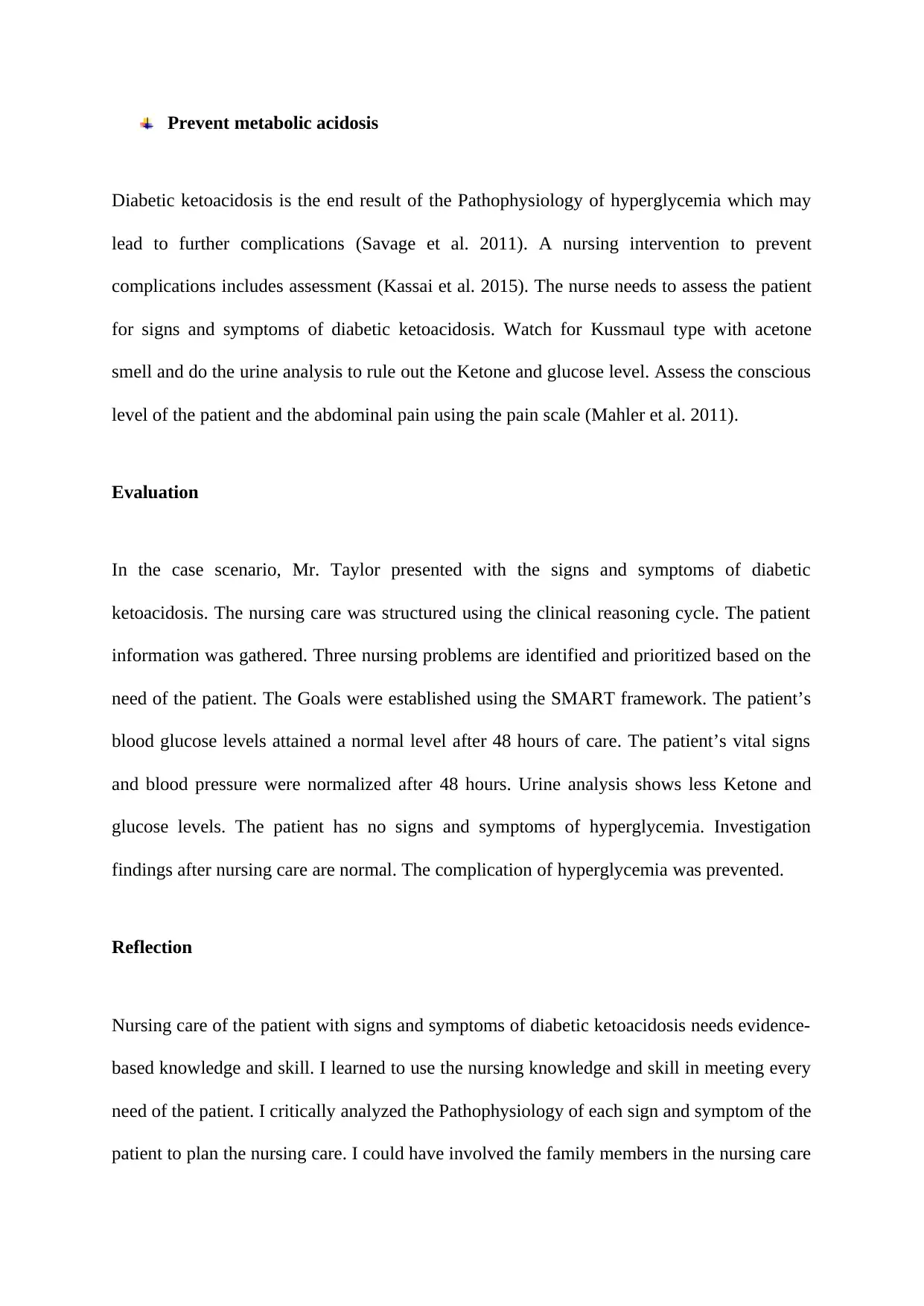
Prevent metabolic acidosis
Diabetic ketoacidosis is the end result of the Pathophysiology of hyperglycemia which may
lead to further complications (Savage et al. 2011). A nursing intervention to prevent
complications includes assessment (Kassai et al. 2015). The nurse needs to assess the patient
for signs and symptoms of diabetic ketoacidosis. Watch for Kussmaul type with acetone
smell and do the urine analysis to rule out the Ketone and glucose level. Assess the conscious
level of the patient and the abdominal pain using the pain scale (Mahler et al. 2011).
Evaluation
In the case scenario, Mr. Taylor presented with the signs and symptoms of diabetic
ketoacidosis. The nursing care was structured using the clinical reasoning cycle. The patient
information was gathered. Three nursing problems are identified and prioritized based on the
need of the patient. The Goals were established using the SMART framework. The patient’s
blood glucose levels attained a normal level after 48 hours of care. The patient’s vital signs
and blood pressure were normalized after 48 hours. Urine analysis shows less Ketone and
glucose levels. The patient has no signs and symptoms of hyperglycemia. Investigation
findings after nursing care are normal. The complication of hyperglycemia was prevented.
Reflection
Nursing care of the patient with signs and symptoms of diabetic ketoacidosis needs evidence-
based knowledge and skill. I learned to use the nursing knowledge and skill in meeting every
need of the patient. I critically analyzed the Pathophysiology of each sign and symptom of the
patient to plan the nursing care. I could have involved the family members in the nursing care
Diabetic ketoacidosis is the end result of the Pathophysiology of hyperglycemia which may
lead to further complications (Savage et al. 2011). A nursing intervention to prevent
complications includes assessment (Kassai et al. 2015). The nurse needs to assess the patient
for signs and symptoms of diabetic ketoacidosis. Watch for Kussmaul type with acetone
smell and do the urine analysis to rule out the Ketone and glucose level. Assess the conscious
level of the patient and the abdominal pain using the pain scale (Mahler et al. 2011).
Evaluation
In the case scenario, Mr. Taylor presented with the signs and symptoms of diabetic
ketoacidosis. The nursing care was structured using the clinical reasoning cycle. The patient
information was gathered. Three nursing problems are identified and prioritized based on the
need of the patient. The Goals were established using the SMART framework. The patient’s
blood glucose levels attained a normal level after 48 hours of care. The patient’s vital signs
and blood pressure were normalized after 48 hours. Urine analysis shows less Ketone and
glucose levels. The patient has no signs and symptoms of hyperglycemia. Investigation
findings after nursing care are normal. The complication of hyperglycemia was prevented.
Reflection
Nursing care of the patient with signs and symptoms of diabetic ketoacidosis needs evidence-
based knowledge and skill. I learned to use the nursing knowledge and skill in meeting every
need of the patient. I critically analyzed the Pathophysiology of each sign and symptom of the
patient to plan the nursing care. I could have involved the family members in the nursing care
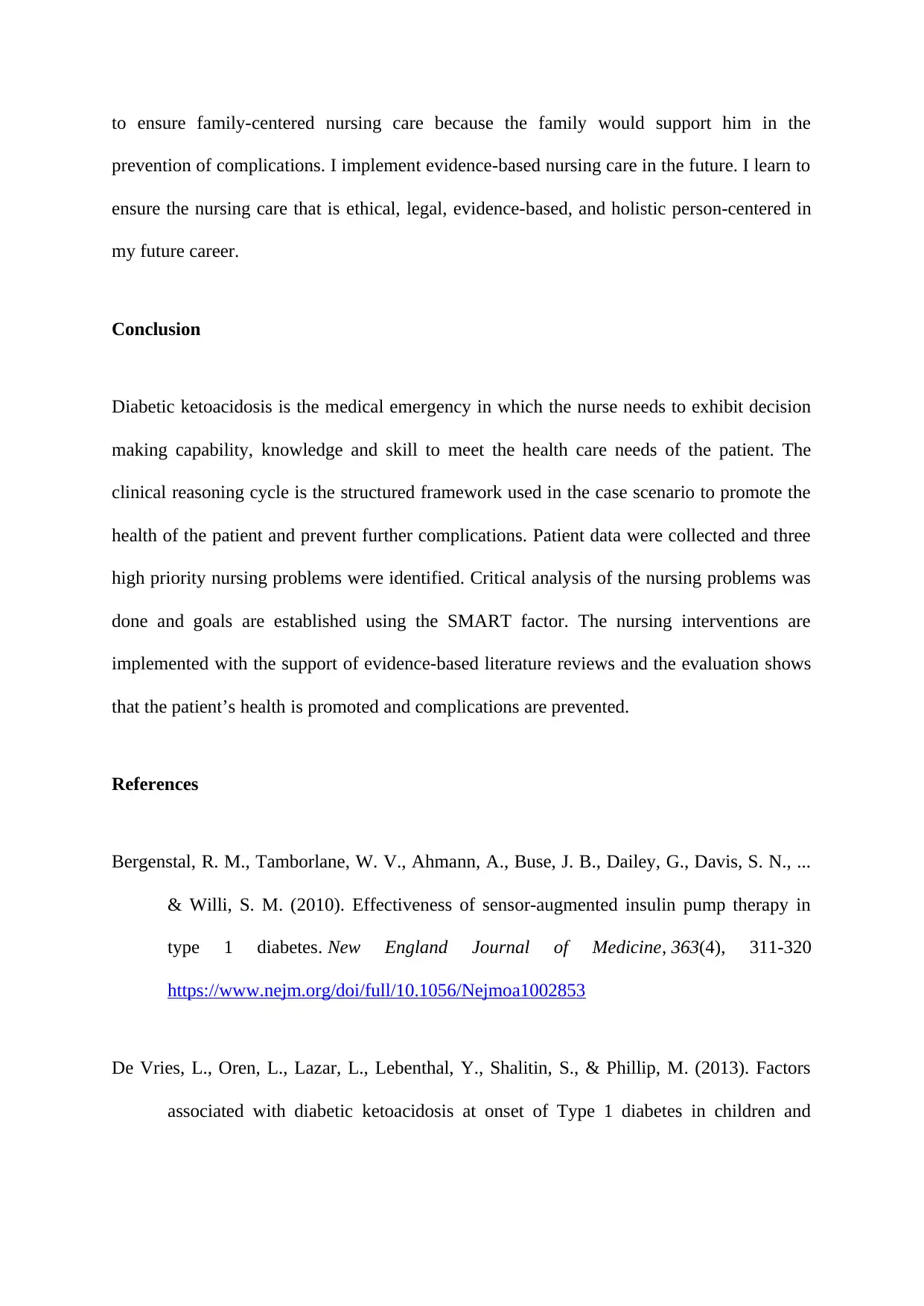
to ensure family-centered nursing care because the family would support him in the
prevention of complications. I implement evidence-based nursing care in the future. I learn to
ensure the nursing care that is ethical, legal, evidence-based, and holistic person-centered in
my future career.
Conclusion
Diabetic ketoacidosis is the medical emergency in which the nurse needs to exhibit decision
making capability, knowledge and skill to meet the health care needs of the patient. The
clinical reasoning cycle is the structured framework used in the case scenario to promote the
health of the patient and prevent further complications. Patient data were collected and three
high priority nursing problems were identified. Critical analysis of the nursing problems was
done and goals are established using the SMART factor. The nursing interventions are
implemented with the support of evidence-based literature reviews and the evaluation shows
that the patient’s health is promoted and complications are prevented.
References
Bergenstal, R. M., Tamborlane, W. V., Ahmann, A., Buse, J. B., Dailey, G., Davis, S. N., ...
& Willi, S. M. (2010). Effectiveness of sensor-augmented insulin pump therapy in
type 1 diabetes. New England Journal of Medicine, 363(4), 311-320
https://www.nejm.org/doi/full/10.1056/Nejmoa1002853
De Vries, L., Oren, L., Lazar, L., Lebenthal, Y., Shalitin, S., & Phillip, M. (2013). Factors
associated with diabetic ketoacidosis at onset of Type 1 diabetes in children and
prevention of complications. I implement evidence-based nursing care in the future. I learn to
ensure the nursing care that is ethical, legal, evidence-based, and holistic person-centered in
my future career.
Conclusion
Diabetic ketoacidosis is the medical emergency in which the nurse needs to exhibit decision
making capability, knowledge and skill to meet the health care needs of the patient. The
clinical reasoning cycle is the structured framework used in the case scenario to promote the
health of the patient and prevent further complications. Patient data were collected and three
high priority nursing problems were identified. Critical analysis of the nursing problems was
done and goals are established using the SMART factor. The nursing interventions are
implemented with the support of evidence-based literature reviews and the evaluation shows
that the patient’s health is promoted and complications are prevented.
References
Bergenstal, R. M., Tamborlane, W. V., Ahmann, A., Buse, J. B., Dailey, G., Davis, S. N., ...
& Willi, S. M. (2010). Effectiveness of sensor-augmented insulin pump therapy in
type 1 diabetes. New England Journal of Medicine, 363(4), 311-320
https://www.nejm.org/doi/full/10.1056/Nejmoa1002853
De Vries, L., Oren, L., Lazar, L., Lebenthal, Y., Shalitin, S., & Phillip, M. (2013). Factors
associated with diabetic ketoacidosis at onset of Type 1 diabetes in children and
Paraphrase This Document
Need a fresh take? Get an instant paraphrase of this document with our AI Paraphraser
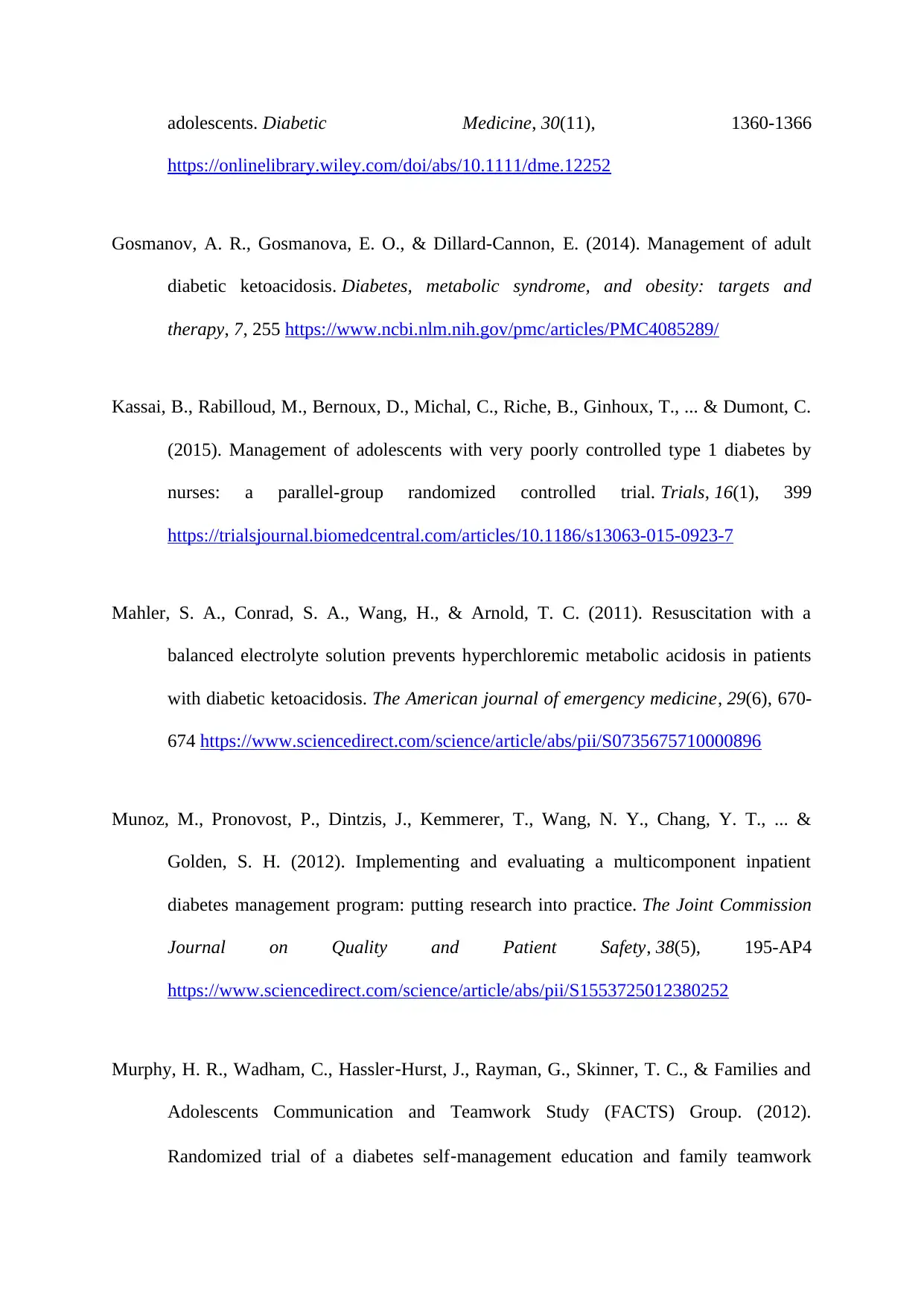
adolescents. Diabetic Medicine, 30(11), 1360-1366
https://onlinelibrary.wiley.com/doi/abs/10.1111/dme.12252
Gosmanov, A. R., Gosmanova, E. O., & Dillard-Cannon, E. (2014). Management of adult
diabetic ketoacidosis. Diabetes, metabolic syndrome, and obesity: targets and
therapy, 7, 255 https://www.ncbi.nlm.nih.gov/pmc/articles/PMC4085289/
Kassai, B., Rabilloud, M., Bernoux, D., Michal, C., Riche, B., Ginhoux, T., ... & Dumont, C.
(2015). Management of adolescents with very poorly controlled type 1 diabetes by
nurses: a parallel-group randomized controlled trial. Trials, 16(1), 399
https://trialsjournal.biomedcentral.com/articles/10.1186/s13063-015-0923-7
Mahler, S. A., Conrad, S. A., Wang, H., & Arnold, T. C. (2011). Resuscitation with a
balanced electrolyte solution prevents hyperchloremic metabolic acidosis in patients
with diabetic ketoacidosis. The American journal of emergency medicine, 29(6), 670-
674 https://www.sciencedirect.com/science/article/abs/pii/S0735675710000896
Munoz, M., Pronovost, P., Dintzis, J., Kemmerer, T., Wang, N. Y., Chang, Y. T., ... &
Golden, S. H. (2012). Implementing and evaluating a multicomponent inpatient
diabetes management program: putting research into practice. The Joint Commission
Journal on Quality and Patient Safety, 38(5), 195-AP4
https://www.sciencedirect.com/science/article/abs/pii/S1553725012380252
Murphy, H. R., Wadham, C., Hassler‐Hurst, J., Rayman, G., Skinner, T. C., & Families and
Adolescents Communication and Teamwork Study (FACTS) Group. (2012).
Randomized trial of a diabetes self‐management education and family teamwork
https://onlinelibrary.wiley.com/doi/abs/10.1111/dme.12252
Gosmanov, A. R., Gosmanova, E. O., & Dillard-Cannon, E. (2014). Management of adult
diabetic ketoacidosis. Diabetes, metabolic syndrome, and obesity: targets and
therapy, 7, 255 https://www.ncbi.nlm.nih.gov/pmc/articles/PMC4085289/
Kassai, B., Rabilloud, M., Bernoux, D., Michal, C., Riche, B., Ginhoux, T., ... & Dumont, C.
(2015). Management of adolescents with very poorly controlled type 1 diabetes by
nurses: a parallel-group randomized controlled trial. Trials, 16(1), 399
https://trialsjournal.biomedcentral.com/articles/10.1186/s13063-015-0923-7
Mahler, S. A., Conrad, S. A., Wang, H., & Arnold, T. C. (2011). Resuscitation with a
balanced electrolyte solution prevents hyperchloremic metabolic acidosis in patients
with diabetic ketoacidosis. The American journal of emergency medicine, 29(6), 670-
674 https://www.sciencedirect.com/science/article/abs/pii/S0735675710000896
Munoz, M., Pronovost, P., Dintzis, J., Kemmerer, T., Wang, N. Y., Chang, Y. T., ... &
Golden, S. H. (2012). Implementing and evaluating a multicomponent inpatient
diabetes management program: putting research into practice. The Joint Commission
Journal on Quality and Patient Safety, 38(5), 195-AP4
https://www.sciencedirect.com/science/article/abs/pii/S1553725012380252
Murphy, H. R., Wadham, C., Hassler‐Hurst, J., Rayman, G., Skinner, T. C., & Families and
Adolescents Communication and Teamwork Study (FACTS) Group. (2012).
Randomized trial of a diabetes self‐management education and family teamwork
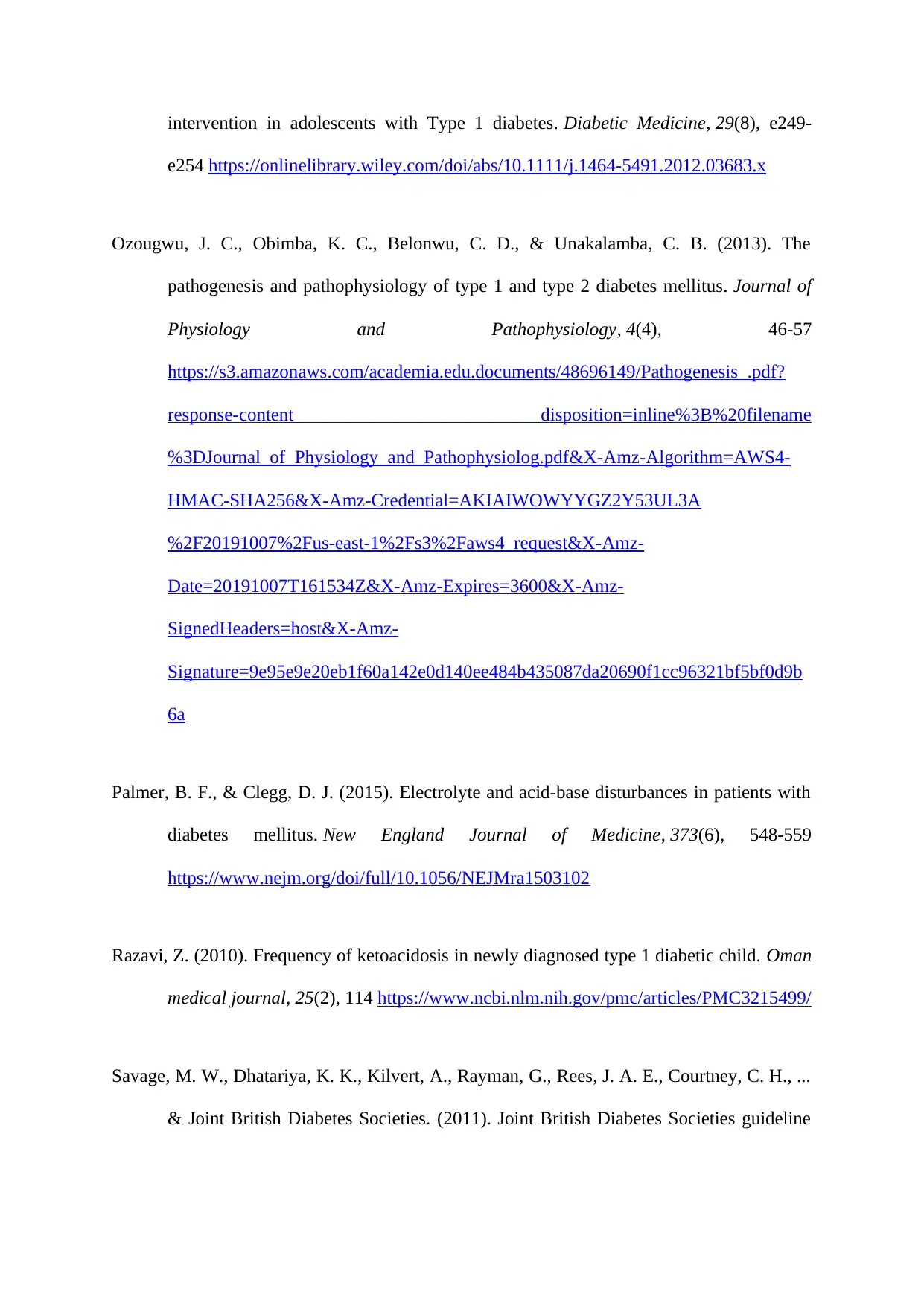
intervention in adolescents with Type 1 diabetes. Diabetic Medicine, 29(8), e249-
e254 https://onlinelibrary.wiley.com/doi/abs/10.1111/j.1464-5491.2012.03683.x
Ozougwu, J. C., Obimba, K. C., Belonwu, C. D., & Unakalamba, C. B. (2013). The
pathogenesis and pathophysiology of type 1 and type 2 diabetes mellitus. Journal of
Physiology and Pathophysiology, 4(4), 46-57
https://s3.amazonaws.com/academia.edu.documents/48696149/Pathogenesis_.pdf?
response-content disposition=inline%3B%20filename
%3DJournal_of_Physiology_and_Pathophysiolog.pdf&X-Amz-Algorithm=AWS4-
HMAC-SHA256&X-Amz-Credential=AKIAIWOWYYGZ2Y53UL3A
%2F20191007%2Fus-east-1%2Fs3%2Faws4_request&X-Amz-
Date=20191007T161534Z&X-Amz-Expires=3600&X-Amz-
SignedHeaders=host&X-Amz-
Signature=9e95e9e20eb1f60a142e0d140ee484b435087da20690f1cc96321bf5bf0d9b
6a
Palmer, B. F., & Clegg, D. J. (2015). Electrolyte and acid-base disturbances in patients with
diabetes mellitus. New England Journal of Medicine, 373(6), 548-559
https://www.nejm.org/doi/full/10.1056/NEJMra1503102
Razavi, Z. (2010). Frequency of ketoacidosis in newly diagnosed type 1 diabetic child. Oman
medical journal, 25(2), 114 https://www.ncbi.nlm.nih.gov/pmc/articles/PMC3215499/
Savage, M. W., Dhatariya, K. K., Kilvert, A., Rayman, G., Rees, J. A. E., Courtney, C. H., ...
& Joint British Diabetes Societies. (2011). Joint British Diabetes Societies guideline
e254 https://onlinelibrary.wiley.com/doi/abs/10.1111/j.1464-5491.2012.03683.x
Ozougwu, J. C., Obimba, K. C., Belonwu, C. D., & Unakalamba, C. B. (2013). The
pathogenesis and pathophysiology of type 1 and type 2 diabetes mellitus. Journal of
Physiology and Pathophysiology, 4(4), 46-57
https://s3.amazonaws.com/academia.edu.documents/48696149/Pathogenesis_.pdf?
response-content disposition=inline%3B%20filename
%3DJournal_of_Physiology_and_Pathophysiolog.pdf&X-Amz-Algorithm=AWS4-
HMAC-SHA256&X-Amz-Credential=AKIAIWOWYYGZ2Y53UL3A
%2F20191007%2Fus-east-1%2Fs3%2Faws4_request&X-Amz-
Date=20191007T161534Z&X-Amz-Expires=3600&X-Amz-
SignedHeaders=host&X-Amz-
Signature=9e95e9e20eb1f60a142e0d140ee484b435087da20690f1cc96321bf5bf0d9b
6a
Palmer, B. F., & Clegg, D. J. (2015). Electrolyte and acid-base disturbances in patients with
diabetes mellitus. New England Journal of Medicine, 373(6), 548-559
https://www.nejm.org/doi/full/10.1056/NEJMra1503102
Razavi, Z. (2010). Frequency of ketoacidosis in newly diagnosed type 1 diabetic child. Oman
medical journal, 25(2), 114 https://www.ncbi.nlm.nih.gov/pmc/articles/PMC3215499/
Savage, M. W., Dhatariya, K. K., Kilvert, A., Rayman, G., Rees, J. A. E., Courtney, C. H., ...
& Joint British Diabetes Societies. (2011). Joint British Diabetes Societies guideline
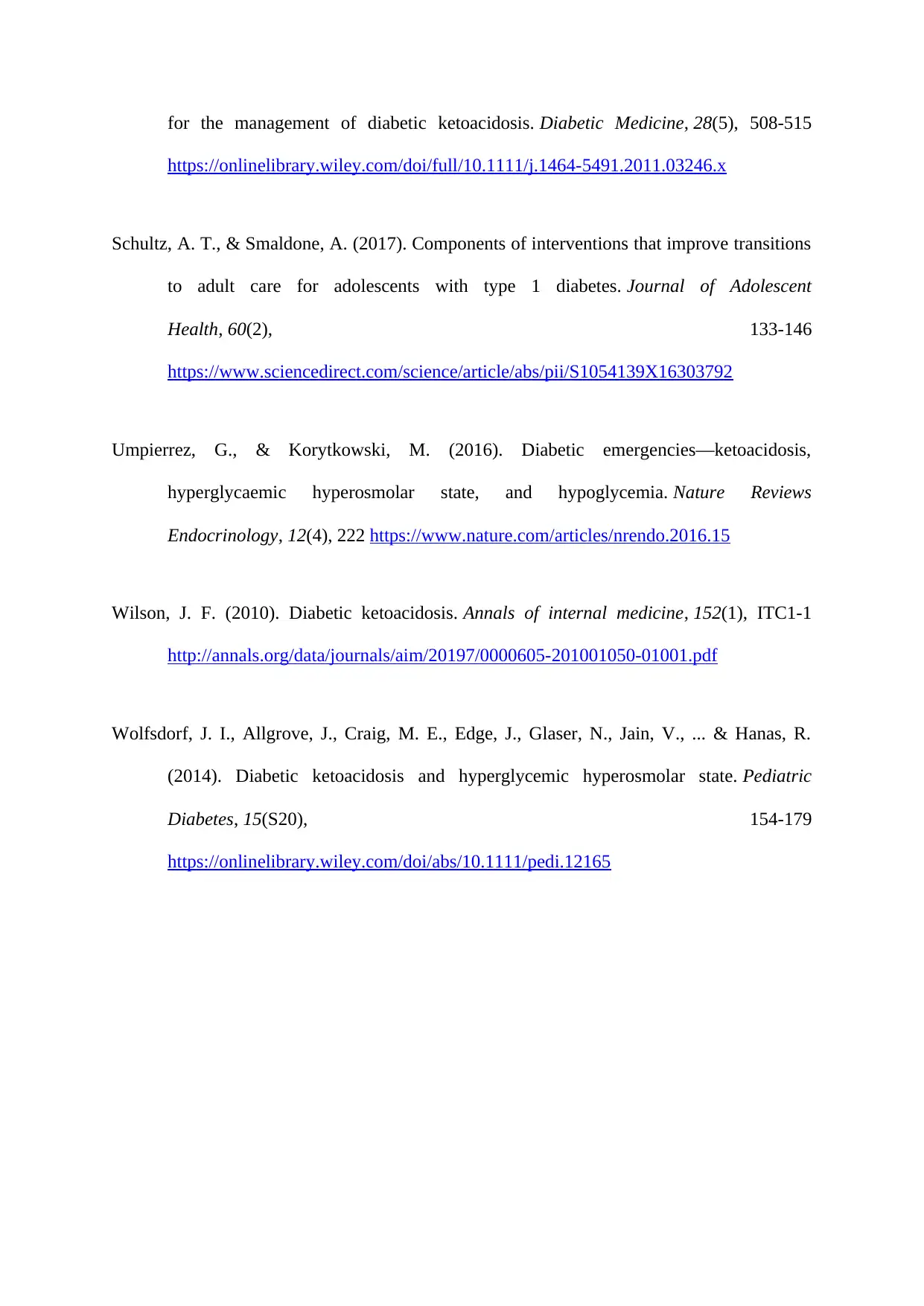
for the management of diabetic ketoacidosis. Diabetic Medicine, 28(5), 508-515
https://onlinelibrary.wiley.com/doi/full/10.1111/j.1464-5491.2011.03246.x
Schultz, A. T., & Smaldone, A. (2017). Components of interventions that improve transitions
to adult care for adolescents with type 1 diabetes. Journal of Adolescent
Health, 60(2), 133-146
https://www.sciencedirect.com/science/article/abs/pii/S1054139X16303792
Umpierrez, G., & Korytkowski, M. (2016). Diabetic emergencies—ketoacidosis,
hyperglycaemic hyperosmolar state, and hypoglycemia. Nature Reviews
Endocrinology, 12(4), 222 https://www.nature.com/articles/nrendo.2016.15
Wilson, J. F. (2010). Diabetic ketoacidosis. Annals of internal medicine, 152(1), ITC1-1
http://annals.org/data/journals/aim/20197/0000605-201001050-01001.pdf
Wolfsdorf, J. I., Allgrove, J., Craig, M. E., Edge, J., Glaser, N., Jain, V., ... & Hanas, R.
(2014). Diabetic ketoacidosis and hyperglycemic hyperosmolar state. Pediatric
Diabetes, 15(S20), 154-179
https://onlinelibrary.wiley.com/doi/abs/10.1111/pedi.12165
https://onlinelibrary.wiley.com/doi/full/10.1111/j.1464-5491.2011.03246.x
Schultz, A. T., & Smaldone, A. (2017). Components of interventions that improve transitions
to adult care for adolescents with type 1 diabetes. Journal of Adolescent
Health, 60(2), 133-146
https://www.sciencedirect.com/science/article/abs/pii/S1054139X16303792
Umpierrez, G., & Korytkowski, M. (2016). Diabetic emergencies—ketoacidosis,
hyperglycaemic hyperosmolar state, and hypoglycemia. Nature Reviews
Endocrinology, 12(4), 222 https://www.nature.com/articles/nrendo.2016.15
Wilson, J. F. (2010). Diabetic ketoacidosis. Annals of internal medicine, 152(1), ITC1-1
http://annals.org/data/journals/aim/20197/0000605-201001050-01001.pdf
Wolfsdorf, J. I., Allgrove, J., Craig, M. E., Edge, J., Glaser, N., Jain, V., ... & Hanas, R.
(2014). Diabetic ketoacidosis and hyperglycemic hyperosmolar state. Pediatric
Diabetes, 15(S20), 154-179
https://onlinelibrary.wiley.com/doi/abs/10.1111/pedi.12165
1 out of 10
Related Documents
Your All-in-One AI-Powered Toolkit for Academic Success.
+13062052269
info@desklib.com
Available 24*7 on WhatsApp / Email
![[object Object]](/_next/static/media/star-bottom.7253800d.svg)
Unlock your academic potential
© 2024 | Zucol Services PVT LTD | All rights reserved.





